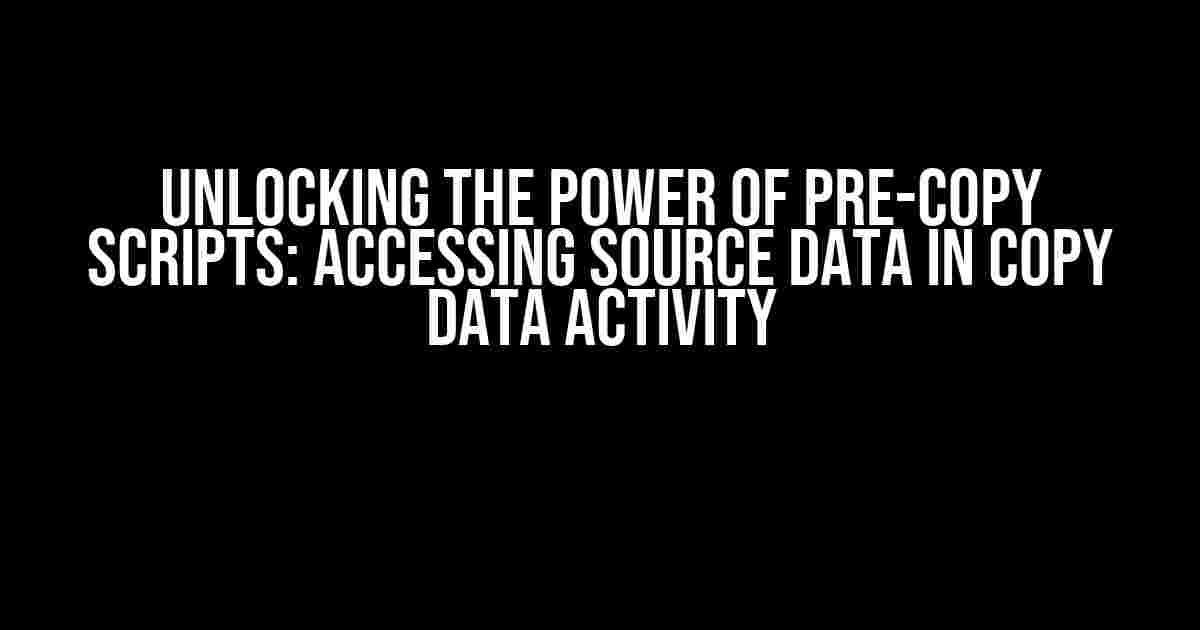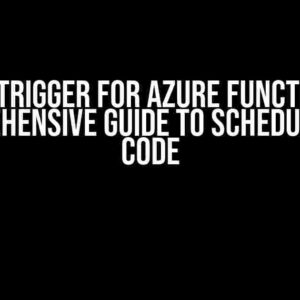Are you tired of feeling limited by the constraints of traditional data copying methods? Do you want to take your data integration game to the next level? Look no further! In this article, we’ll dive into the world of pre-copy scripts in Copy Data Activity and show you how to access the source data, unlocking a wealth of possibilities for data transformation and manipulation.
What are Pre-Copy Scripts?
Before we dive into the nitty-gritty, let’s take a step back and understand what pre-copy scripts are. In Copy Data Activity, a pre-copy script is a script that runs before the data is copied from the source to the sink. This script allows you to perform various operations, such as data validation, data transformation, and data filtering, before the data is even copied.
Pre-copy scripts are essential in data integration workflows, as they enable you to manipulate and transform the source data in real-time, making it possible to cleanse, enrich, and prepare the data for its destination.
Accessing Source Data in Pre-Copy Script
Now that we’ve established the importance of pre-copy scripts, let’s get to the good stuff – accessing the source data in the pre-copy script. To do this, you’ll need to use the `src` object, which represents the source data.
// Get the source data
var srcData = src;
The `src` object is an array of objects, where each object represents a single row of data from the source. You can access each column of the source data using the column name as a property of the `src` object.
// Access the 'Name' column
var names = src.Name;
// Access the 'Age' column
var ages = src.Age;
You can also use the `src` object to perform more complex operations, such as filtering and sorting the source data.
// Filter the source data to only include rows where 'Age' is greater than 18
var filteredData = src.filter(function(row) {
return row.Age > 18;
});
// Sort the source data by 'Name' in ascending order
var sortedData = src.sort(function(a, b) {
return a.Name.localeCompare(b.Name);
});
Using the `src` Object in Pre-Copy Script
Now that we’ve covered the basics of accessing the source data using the `src` object, let’s put it to use in a pre-copy script.
Suppose we have a source dataset with two columns – `Name` and `Age`. We want to create a new column called `IsValid` that indicates whether the `Age` is valid (i.e., greater than 18).
// Create a new column called 'IsValid'
src.forEach(function(row) {
row.IsValid = row.Age > 18 ? true : false;
});
In this script, we’re using the `src` object to iterate over each row of the source data. For each row, we’re creating a new column called `IsValid` and setting its value based on the `Age` column.
Common Use Cases for Accessing Source Data in Pre-Copy Script
Accessing the source data in pre-copy script opens up a world of possibilities for data transformation and manipulation. Here are some common use cases:
- Data Validation: Use the `src` object to validate the source data against a set of rules or constraints. For example, you can check if a column contains a specific value or if it falls within a certain range.
- Data Transformation: Use the `src` object to transform the source data in real-time. For example, you can convert a date column from one format to another or perform calculations on numeric columns.
- Data Filtering: Use the `src` object to filter out unwanted rows from the source data. For example, you can filter out rows that contain null or blank values.
- Data Enrichment: Use the `src` object to enrich the source data by adding new columns or values. For example, you can add a new column that contains the current date and time.
Best Practices for Accessing Source Data in Pre-Copy Script
When accessing the source data in pre-copy script, it’s essential to follow best practices to ensure data integrity and performance. Here are some tips:
- Use the `src` object wisely: Avoid using the `src` object to perform complex operations that can impact performance. Instead, use it to perform simple operations that can be executed quickly.
- Optimize your script: Optimize your pre-copy script to minimize the number of iterations and reduce the amount of processing time.
- Use caching: Consider using caching mechanisms to store the results of expensive operations, reducing the need to re-execute them.
- Test and validate: Thoroughly test and validate your pre-copy script to ensure it produces the desired results and doesn’t introduce any errors.
Conclusion
Accessing the source data in pre-copy script is a powerful feature in Copy Data Activity that allows you to manipulate and transform the source data in real-time. By following the instructions and best practices outlined in this article, you’ll be able to unlock the full potential of pre-copy scripts and take your data integration workflows to the next level.
Remember, with great power comes great responsibility. Use the `src` object wisely, and always keep performance and data integrity in mind.
| Keyword | Description |
|---|---|
| Access the source data in pre-copy script in copy data activity | Retrieves the source data in a pre-copy script, allowing for real-time data transformation and manipulation. |
By following the instructions and best practices outlined in this article, you’ll be able to access the source data in pre-copy script and take your data integration workflows to the next level.
Happy scripting!
Frequently Asked Questions
Get answers to your burning questions about accessing source data in pre-copy script in copy data activity!
Can I access the source data in the pre-copy script of a Copy Data activity?
Yes, you can! In the pre-copy script, you can access the source data using the `source` object, which provides information about the source dataset. You can use this object to read data from the source dataset or perform other operations before the copy activity starts.
How do I access the source data in the pre-copy script?
To access the source data, you can use the `read` method of the `source` object. For example, `source.read()` will return an iterator over the rows of the source dataset. You can then use this iterator to process the data as needed.
Can I modify the source data in the pre-copy script?
No, you cannot modify the source data in the pre-copy script. The pre-copy script is designed to read-only access the source data, and any attempts to modify the data will result in an error. If you need to modify the data, you should do so in a separate activity, such as a data transformation activity.
What is the purpose of the pre-copy script in a Copy Data activity?
The pre-copy script is used to perform tasks before the copy activity starts, such as data validation, data transformation, or data filtering. It’s a powerful feature that allows you to customize the copy process and ensure that the data is prepared correctly for copying.
Are there any limitations to accessing source data in the pre-copy script?
Yes, there are some limitations to accessing source data in the pre-copy script. For example, some data sources may not support read-only access, or may have limitations on the amount of data that can be read. Additionally, the pre-copy script has a limited execution time, so complex data processing tasks may not be suitable for this script.


